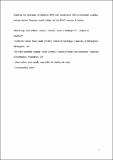Exploring the advantages of multiband fMRI with simultaneous EEG to investigate coupling between gamma frequency neural activity and the BOLD response in humans
Abstract
We established an optimal combination of EEG recording during sparse multiband (MB) fMRI that preserves high-resolution, whole-brain fMRI coverage while enabling broad-band EEG recordings which are uncorrupted by MRI gradient artefacts (GAs). We first determined the safety of simultaneous EEG recording during MB fMRI. Application of MB factor = 4 produced <1°C peak heating of electrode/hardware during 20 min of GE-EPI data acquisition. However, higher SAR sequences require specific safety testing, with greater heating observed using PCASL with MB factor = 4. Heating was greatest in the electrocardiogram channel, likely due to it possessing longest lead length. We investigated the effect of MB factor on the temporal signal-to-noise ratio for a range of GE-EPI sequences (varying MB factor and temporal interval between slice acquisitions). We found that, for our experimental purpose, the optimal acquisition was achieved with MB factor = 3, 3mm isotropic voxels, and 33 slices providing whole head coverage. This sequence afforded a 2.25 s duration quiet period (without GAs) in every 3 s TR. Using this sequence, we demonstrated the ability to record gamma frequency (55–80 Hz) EEG oscillations, in response to right index finger abduction, that are usually obscured by GAs during continuous fMRI data acquisition. In this novel application of EEG-MB fMRI to a motor task, we observed a positive correlation between gamma and BOLD responses in bilateral motor regions. These findings support and extend previous work regarding coupling between neural and hemodynamic measures of brain activity in humans and showcase the utility of EEG-MB fMRI for future investigations.
Citation
Uji , M , Wilson , R , Francis , S , Mullinger , K & Mayhew , S 2018 , ' Exploring the advantages of multiband fMRI with simultaneous EEG to investigate coupling between gamma frequency neural activity and the BOLD response in humans ' , Human Brain Mapping , vol. 39 , no. 4 , pp. 1673-1687 . https://doi.org/10.1002/hbm.23943
Publication
Human Brain Mapping
Status
Peer reviewed
ISSN
1065-9471Type
Journal article
Description
The authors thank the Birmingham Nottingham Strategic Collaboration Fund for supporting this work and MU and a University of Nottingham Anne McLaren Fellowship for funding KJM and a University of Birmingham Fellowship for funding SDM.Collections
Items in the St Andrews Research Repository are protected by copyright, with all rights reserved, unless otherwise indicated.

